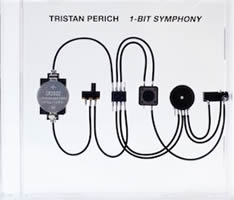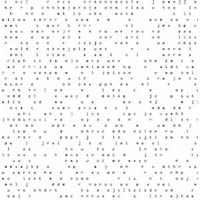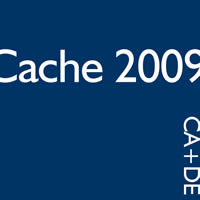EA Bucket 13.
|
Grant Chu Covell [November 2011.]
Dimitri VOUDOURIS: AΛΘ = Φ (2005-08); UVIVI (2008); 1:Θφ4 (2007); ONTA (2003-05). Pogus P21056-2 (http://www.pogus.com/). The open minded will set aside Voudouris’ opaque titles and impenetrable notes and discover four works whose concrète techniques confound associations. At its premiere, 24 robotic speakers dispersed AΛΘ = Φ’s linguistically impossible synthetic sounds which chart an emotionally pure pre-language. Its title derived from the Zulu for “daybreak,” UVIVI pairs with choreography. Automobile traffic models (on Mao Tse Tung Avenue) dictated the piece’s events. 1:Θφ4 works with voices and computerized speech synthesis. Like the substantive AΛΘ = Φ, ONTA for voice and electronics portrays the city as stimulant. Vocalist Alecia Van Huysteen becomes absorbed within ONTA’s density.
Tristan PERICH: 1-Bit Symphony (2009-10). Cantaloupe CA21054 (http://www.cantaloupemusic.com/). Distributed in the US by Naxos (http://www.naxos.com/). We revisit yesteryear’s gruff electronics, cleverly packaged to create an intimate real-time performance. Set aside your Grados and scrounge in the junk drawer for your Sony Walkman headphones, or better yet, use a headset they used to dispense on airplanes. Perich’s gadgetry lives in a CD case with a ¼-inch jack puncturing the spine for attaching a listening device. The internals can be spied through the clear jewel box: battery housing, on/off switch, a music-producing chip, a fast-forward button, volume control, and the headphone socket. An accompanying paper sheet that won’t fit in the case unfolds to reveal the computer program’s code. I admit being unclear on the “1-bit” concept, which to my mind means merely two possibilities: 0 or 1. However, Perich uses “1-bit” to mean music that never has more than one bit of information being played at any given time, which still doesn’t add up given the multiple voices. Perich busies with rapid pulsing and only the mildest rhythmic complexity with his limited gamut. “Symphony” implies aspiration, neither form nor structure. It’s a pretty cool delivery vehicle, but the five movements (the last can loop indefinitely) require effort. Spying any stereo effects necessitates unpleasant volume. It was also hard to tell where movements actually began and ended, despite the helpful advance button. But this one’s a keeper if only for its novelty.
Antoine BEUGER: Two (2009)*; Too (2009). Irene Kurka* (sop), Jürg Frey* (clar), Ko Ishikawa (sho), Rhodri Davies (Irish harp). Edition Wandelweiser Records EWR 0903/04 (2 CDs) (http://www.timescraper.de/_e-w-records/_ewr-catalogue/index.html). At first glance this double-set doesn’t belong here. However Beuger’s gentle touch and obliging serendipity produce a lovely opus. As a lapsed composer, I know firsthand that rare occurrence when independently conceived materials happily coalesce. Non-practitioners suspect Mahler’s ability to set the Veni creator hymn without the words at hand. Beuger’s Too assembles two separate recordings: the hour-long soprano and clarinet duet Two, and sho and Irish harp in the 2006 three drops of rain / east wind / ocean. Two in Too really does sound like a different piece. Beuger’s single moments braced with silence create an unlikely quartet filled with compelling intersections.
Jexper HOLMEN: Oort Cloud (2008). Martin Stig ANDERSEN: Cosmogryal Echo (2010). Frode Andersen, Frode Haltli (accordions), Torben Snekkestad (sop sax). Dacapo 8.226562 (http://www.dacapo-records.dk/). Distributed in the US by Naxos (http://www.naxos.com/). The usually elegant Dacapo astonishes with a monstrously unfriendly release. The Danish label must not be relying upon retail sales since this disc isn’t likely to be found in a store. Like a joke that’s gone too far, the cover’s random letters extend into the meaningless multipage booklet. For contents and credits you must consult Dacapo’s website or decipher the spiral printed upon the disc. The single, nearly hour-long track encompasses two pieces, Holmen’s Oort Cloud, a paean to heavily reverberating suspended tones produced from two accordions plus saxophone, and Andersen’s shorter electronic answer. The transient sounds compel modest attention; I stuck with it expecting a final, and as it happens, unrealized, gag.
“Cache 2007.” Var comps. Canadian Electroacoustic Community PeP 012 (1 CD) (http://cec.sonus.ca/). “Cache 2008.” Var comps. Canadian Electroacoustic Community PeP 013 (1 CD) (http://cec.sonus.ca/). “Cache 2009; CA + DE.” Var comps. Canadian Electroacoustic Community PeP 014 (2 CDs) (http://cec.sonus.ca/ and http://www.degem.de/). CEC’s annual contest for young and emerging sound artists results in a CD with the top-juried submissions programmed alphabetically by composers’ last names. The 2009 open call spanned Canada and Germany. The CEC website offers bilingual notes, a score or two, and all the submitted works. The creators’ musings reflect varied levels of maturity and experience. Aesthetic boundaries between concrète and pure synthesis have blurred. Theme and variations and streams of consciousness occur more frequently than voices and narrative, and industrial clutter and technological detritus take precedence over nightmares and dreams. In 2009 the average duration grew, and the works found greater depth and slower pacing. I did not methodically shuffle between the two 2009 discs, but the Germans seemed more intense and assertive. Real-life instrumental sounds took starring roles. Notable tracks include: James Duhamel’s MIMIK and Dominic Thibault’s Nuit noire, nuit grise from 2007; Mathieu Arsenault’s Edges and Antonin Provost’s Bourrasques from 2008; Charles Quevillon’s nightmarish Frette and Florian Hartlieb’s Im vorderen Zimmer des hinteren Raums from 2009.
John RICHARDS: Suite for Piano and Electronics (2002). Var. comps, var. remixes. GéNIA (pno). Nonclassical Recordings NONCLSSCD002 (http://www.nonclassical.co.uk/). Distributed in the US by Naxos (http://www.naxos.com/). Gabriel PROKOFIEV: Concerto for Turntables and Orchestra (2006). Var. comps, var. remixes. DJ Yoda (turntables), Heritage Orchestra, James Buckley (cond.). Nonclassical Recordings NONCLSSCD005 (http://www.nonclassical.co.uk/). Distributed in the US by Naxos (http://www.naxos.com/). How can a Suite be two movements? Richards produces interesting sounds despite the improperly named structure, Evgenia Chudinovich’s multi-case moniker, and the remix composers’ poor orthography. On the other hand, Prokofiev’s vivid Concerto — say hello to Sergei’s grandson — warrants repeating whether you feel inclined to bust a move or stay rooted. It’s unclear what vinyl the turntablist employs and whether unfamiliarity accounts for the ensemble’s rigidity. Multi-person theme and variations appear to be all the rage. Why must remixes make their loops so evident or feel so inclined to clomp out a beat? Perhaps I’m alone in loathing a drum set’s emergence after the second measure. What does it say when the remixes are more entertaining than their originals?
Mari KIMURA: Subharmonic Partita (2005); Gemini (1995); Vitessimo (2007); Clone Barcarolle (2009); Six Caprices for Subharmonics (1997-98); Two Clos (2010); Izquierda Y Derecha (1998); ALT (1992); Bucknerian (2002)1. Mari Kimura (vln, computer), Thomas Buckner1 (vce). Mutable Music 17542 (1 CD) (http://www.mutablemusic.com/). A slowly moving bow applied with heavy pressure produces a grinding sound which Lachenmann among others have used to marvelous effect. Kimura has determined optimal combinations of speed and pressure to produce repeatable, identifiable pitches, and has in essence dropped her violin’s lower range down an octave or thereabouts. The effect bears similarity to the extension bass players employ to take the E string down to C, and the ear quickly adjusts. Kimura couples technique with invention, and several pieces combine tape and electronics. Bucknerian exposes Kimura’s curious collaboration with vocalist Buckner.
Simon STEEN-ANDERSEN: On And Off And To And Fro (2008); Rerendered (2003); In Her Frown (2007); Pretty Sound (Up and Down) (2009); Study for String Instrument #2 (2009). Asamisimasa. Dacapo 8.226523 (http://www.dacaporecords.dk/). Distributed in the US by Naxos (http://www.naxos.com/). Steen-Andersen’s trademarked mode appears to be virtuosic amplification including megaphones. A small ensemble gets up close and personal with breathing sounds, manipulating paper and other customarily meek inside-piano noises. On And Off And To And Fro requires saxophone, vibraphone, cello, three additional players with megaphones, and a conductor. Gentle purring, extended noises and sturdy sine waves coalesce for an engrossing quarter-hour plus, ofttimes bowed vibraphone, vibratoless cello and megaphone blend indistinguishably. In Rerendered a pianist encounters two assistants busying within the instrument. In Her Frown’s two performers explore paper, voices and noise. Steen-Andersen numbly shifts perspective between quiet and loud events through amplification and adept normalization as demonstrated in Pretty Sound (Up and Down) which presents a wide degree of ordinarily subtle piano sounds. The Study for String Instrument #2 requires three players: cello, electric guitar and one person on whammy pedal.
David LUMSDAINE: The Big Meeting (1972). NMC Records NMC D171 (1 CD) (http://www.nmcrec.co.uk/). Distributed in the US by Naxos (http://www.naxos.com/). Almost every year since 1871, English coal miners have gathered in brotherhood to march, sing, and listen to speeches in and around Durham. At its peak, the Durham Miner’s Gala was the largest unofficial miner and trade union gathering in the UK, attracting nearly a quarter-million folk. In 1971, Lumsdaine and several colleagues wandered around the momentarily besieged town documenting the noise and sounds. Incorporating electronic effects, filtering and spatialization, Lumsdaine built an hour-long documentary collage uniting bells, marching bands, hymns, and conversations. Despite the occasional conflagration and bits that repeat and distort, Lumsdaine’s cautiously respectful touch intimates quaintness and awe. The Gala has since peaked and the mines have been closed, but we do have this document.
Andersen, Beuger, G Prokofiev, Holmen, Kimura, Lumsdaine, Perich, Richards, Steen-Andersen, Voudouris
[More EA Bucket, Grant Chu Covell]
[More
Andersen, Beuger, G Prokofiev, Holmen, Kimura, Lumsdaine, Perich, Richards, Steen-Andersen, Voudouris]
[Previous Article:
Munich Streets and Statues]
[Next Article:
SteinMusic's H2]
|











